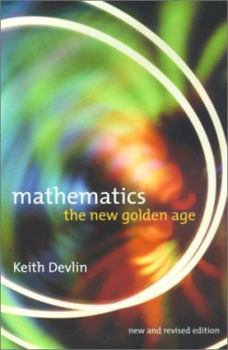Mathematics
Select Format
Select Condition 
Book Overview
Mathematics: The New Golden Age offers a glimpse of the extraordinary vistas and bizarre universes opened up by contemporary mathematicians: Hilbert's tenth problem and the four-color theorem, Gaussian integers, chaotic dynamics and the Mandelbrot set, infinite numbers, and strange number systems. Why a "new golden age"? According to Keith Devlin, we are currently witnessing an astronomical amount of mathematical research. Charting the most...
Format:Paperback
Language:English
ISBN:023111639X
ISBN13:9780231116398
Release Date:March 2001
Publisher:Columbia University Press
Length:336 Pages
Weight:1.08 lbs.
Dimensions:0.9" x 6.0" x 9.0"
Grade Range:Postsecondary and higher
Customer Reviews
5 ratings
2
Published by Thriftbooks.com User , 15 years ago
This book is excellent. It speaks about Number Theory, Group Theory, Topology and also the Clay Math problem about NP vs P problem. Are there are Golden Age in Mathematics? ... May be. Devlin show a bridge for us.
Great Book for Prospective Mathematicians
Published by Thriftbooks.com User , 22 years ago
This book is a comprehensive in-detail overview of a wide rage of mathematical subjects, from Fermat's Last Theorem to topology. If you are considering a mathematical career, this book is a great buy.
Advances in mathematics since 1960
Published by Thriftbooks.com User , 23 years ago
The phrase "Golden Age" is most often used to refer to an era when the dominant players exhibited characteristics that are later called "amateurish." For example, the fifties are often called the golden age of American television and the thirties and forties the golden age of science fiction. However, like most such glittery phrases, it can be redefined to suit ones purposes, and that is what Devlin does here. He takes as his era of consideration the years since 1960. Some of the topics are those that have been resolved in this time span, such as the four-color problem, the classification of simple groups, Hilbert's Tenth Problem, and the Continuum Hypothesis. Others are some that have been created by the advent of computers, such as fractals, chaos, and the efficiency of algorithms. Finally, there are those where only significant progress has been made, such as Fermat's Last Theorem, factoring large numbers, and Knot Theory. All are dealt with in a manner that will allow the non-technical person to understand them. The writing is clear, concise, and direct. With over half of the material dealing directly with work done on computers, it is clear that the author's use of the phrase is correct. However, this era will go down in history as the original golden age of the use of computers in mathematics and not as a new golden age of mathematics alone. Strongly recommended as a primer on major mathematical accomplishments since 1960, this book can be enjoyed by amateurs and professionals alike. Published in Journal of Recreational Mathematics, reprinted with permission
well-written and mind-stretching
Published by Thriftbooks.com User , 24 years ago
This is the best popular math book I've ever read. The first edition of this book was responsible for rekindling my interest in pure mathematics after a long layoff (which has persisted to this day). The author covers some topics that are typically covered in popular math books (such as chaos theory and the difficulty of factoring large prime numbers). Fortunately, most of the book is devoted to topics that are rarely dealt with in such books, such as the classification of finite simple groups, the class number problem, and the Riemann hypothesis. The new edition also contains an expanded section on Fermat's last theorem (which has been proved since the first edition came out). What I like about Devlin's style is that he goes into the math to a much more significant extent than most popular science writers and yet still keeps everything easy to understand for anyone with (say) an understanding of basic calculus. The only (minor) criticism I have of the book is that Devlin often gets tantalizingly close to a major result and then begs off with the statement "the full result can only be understood by specialists". Most of the time, this makes little difference, but with the class number problem (which, among other things, explains why exp(sqrt(163)*Pi) is almost an integer), he leads you along a fascinating journey and then doesn't explain the original motivating problem (why exp(sqrt(163)*Pi) is almost an integer). However, this is a minor nit and doesn't significantly detract from a fascinating book.
An engaging survey for the non-specialist general reader.
Published by Thriftbooks.com User , 24 years ago
From the length of the British coast to the feedback process between order and chaos, Keith Devlin's Mathematics provides a surprisingly non-technical tour of new developments in the field of math since 1960, revising a classic to encompass new theories of the 1980s and 1990s. Mathematician/author Devlin claims we are in a 'new golden age' of math advancements: this links math achievements to new science findings as a whole.





